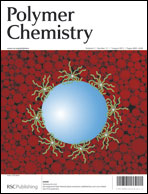Thiourea-functionalized poly(phenyleneethynylene): fluorescent chemosensors for anions and cations†
Abstract
A novel poly(phenyleneethynylene) containing thiourea groups [poly(1)] was synthesized. The anion sensing ability of poly(1) was assessed using tetra-n-butylammonium (TBA) salts of a series of anions in DMF. The addition of F− changed the color of the polymer solution in DMF from yellow to orange and quenched the fluorescence, whereas the visible color and fluorescence of the solution only varied slightly upon the addition of Cl−, HSO4−, Br−, CH3COO−, C6H5COO−, and NO3−; this indicates that poly(1) exhibits an F− sensing ability. 1H NMR titrations of poly(1) revealed that the colorimetric and fluorescent response of poly(1) is triggered by thiourea/F− hydrogen bonding. Poly(1) also exhibited a turn-off fluorescence Ag+ sensing ability. The addition of Ag+ quenched the fluorescence of the polymer, while the addition of Pb2+, Zn2+, Cu2+, Mn2+, K+, Na+, and Co2+ resulted in only slight changes to the fluorescence. The sensor containing poly(1) and Ag+ shows a turn-on fluorescence adenosine diphosphate (ADP) sensing ability.


 Please wait while we load your content...
Please wait while we load your content...